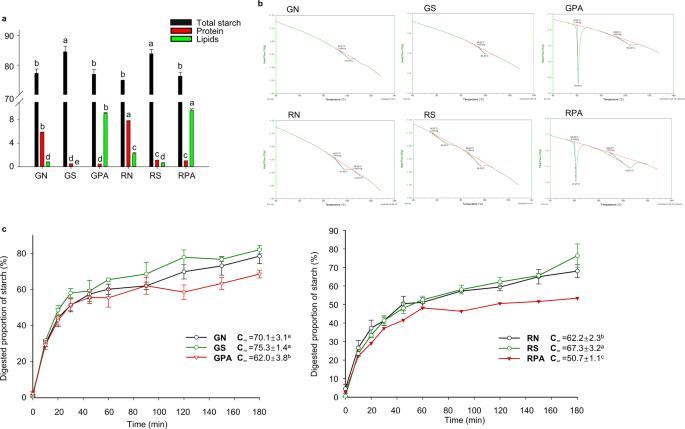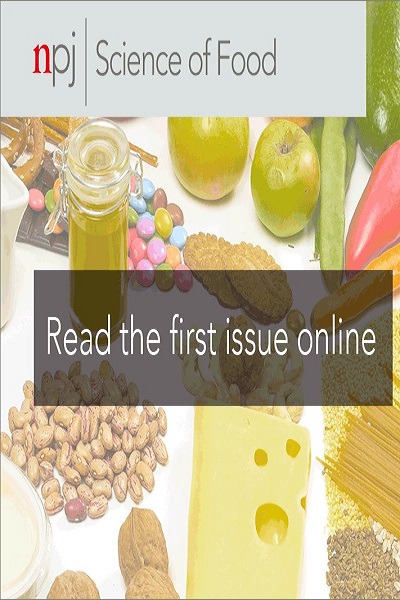脂质络合降低了大米淀粉的消化率,并通过肠道微生物群促进短链脂肪酸的产生。
IF 7.8
1区 农林科学
Q1 FOOD SCIENCE & TECHNOLOGY
引用次数: 0
摘要
本研究以两个直链淀粉和脂质含量不同的水稻品种(RS4和GZ93)为材料,利用其淀粉制备淀粉-棕榈酸复合物。与GZ93相比,RS4样品在其面粉、淀粉和复合物样品中显示出显著更高的脂质含量。静态体外消化表明,RS4样品的消化率明显低于GZ93样品。淀粉-脂质复合物样品的C∞分别比GZ93和RS4中的淀粉样品低17.7%和18.5%。INFOGEST未消化部分随后用于体外结肠发酵。与天然面粉或淀粉样品相比,淀粉-脂质复合物中的短链脂肪酸(SCFA)浓度(主要是乙酸盐和丙酸盐)显著较高。淀粉-脂质复合物产生了独特的微生物组成,导致不同的基因功能,主要与丙酮酸、果糖和甘露糖代谢有关。使用基于模型的代谢产物观察和物种丰度整合2(MIMOSA2),预测SCFA的产生并与肠道微生物群相关联。这些结果表明,将脂质掺入大米淀粉中通过选择性调节肠道微生物群来促进SCFA的产生。本文章由计算机程序翻译,如有差异,请以英文原文为准。

Lipid complexation reduces rice starch digestibility and boosts short-chain fatty acid production via gut microbiota
In this study, two rice varieties (RS4 and GZ93) with different amylose and lipid contents were studied, and their starch was used to prepare starch-palmitic acid complexes. The RS4 samples showed a significantly higher lipid content in their flour, starch, and complex samples compared to GZ93. The static in vitro digestion highlighted that RS4 samples had significantly lower digestibility than the GZ93 samples. The C∞ of the starch-lipid complex samples was found to be 17.7% and 18.5% lower than that of the starch samples in GZ93 and RS4, respectively. The INFOGEST undigested fractions were subsequently used for in vitro colonic fermentation. Short-chain fatty acids (SCFAs) concentrations, mainly acetate, and propionate were significantly higher in starch-lipid complexes compared to native flour or starch samples. Starch-lipid complexes produced a distinctive microbial composition, which resulted in different gene functions, mainly related to pyruvate, fructose, and mannose metabolism. Using Model-based Integration of Metabolite Observations and Species Abundances 2 (MIMOSA2), SCFA production was predicted and associated with the gut microbiota. These results indicated that incorporating lipids into rice starch promotes SCFA production by modulating the gut microbiota selectively.
求助全文
通过发布文献求助,成功后即可免费获取论文全文。
去求助
来源期刊

NPJ Science of Food
FOOD SCIENCE & TECHNOLOGY-
CiteScore
7.50
自引率
1.60%
发文量
53
期刊介绍:
npj Science of Food is an online-only and open access journal publishes high-quality, high-impact papers related to food safety, security, integrated production, processing and packaging, the changes and interactions of food components, and the influence on health and wellness properties of food. The journal will support fundamental studies that advance the science of food beyond the classic focus on processing, thereby addressing basic inquiries around food from the public and industry. It will also support research that might result in innovation of technologies and products that are public-friendly while promoting the United Nations sustainable development goals.
 求助内容:
求助内容: 应助结果提醒方式:
应助结果提醒方式:


